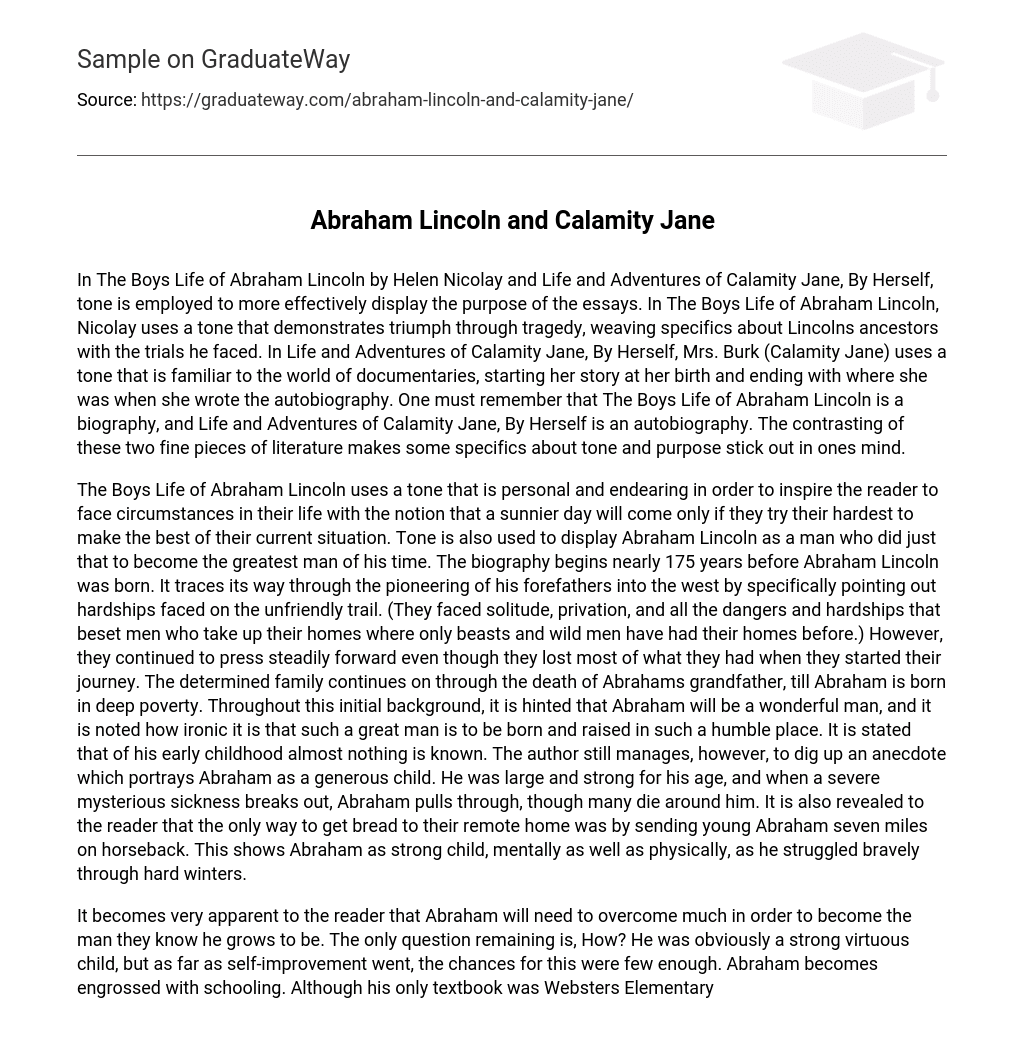The purpose of the essays in The Boys Life of Abraham Lincoln by Helen Nicolay and Life and Adventures of Calamity Jane, By Herself is effectively displayed through the use of tone. Nicolay’s tone in The Boys Life of Abraham Lincoln showcases triumph through tragedy, intertwining details about Lincoln’s ancestors and the challenges he faced. On the other hand, Mrs. Burk (Calamity Jane) employs a familiar tone reminiscent of documentary storytelling in Life and Adventures of Calamity Jane, By Herself, beginning with her birth and concluding with her current state at the time of writing her autobiography. It is important to note that The Boys Life of Abraham Lincoln is a biography, while Life and Adventures of Calamity Jane, By Herself is an autobiography. This juxtaposition between these two literary works highlights noteworthy aspects relating to tone and purpose.
In The Boys Life of Abraham Lincoln, the tone employed is personal and endearing. Its purpose is to motivate readers to face their own circumstances with the belief that a better day will come if they give their all to make the most of their current situation. The tone also showcases Abraham Lincoln as a man who exemplified this mindset in order to become the greatest of his time. The biography begins nearly 175 years prior to Lincoln’s birth, tracing the pioneering journey of his ancestors into the western frontier. It specifically highlights the hardships they encountered on the difficult trail, including solitude, privation, and various dangers. Despite losing most of their belongings at the start of their journey, the resilient family perseveres. The narrative then continues through the death of Lincoln’s grandfather and ultimately leads to Lincoln’s birth in deep poverty. Throughout this initial background, there are hints that Lincoln will grow up to be an extraordinary man. The text acknowledges the irony of such a remarkable individual being born and raised in such humble circumstances. While very little is known about Lincoln’s early childhood, the author manages to uncover an anecdote which depicts him as a generous child. Despite a severe and mysterious illness that claims many lives around him, young Abraham survives due to his strength and resilience.It is revealed that the only way to deliver bread to their remote home was by sending young Abraham seven miles on horseback. This showcases Abraham as a resilient child, both mentally and physically, as he courageously endured challenging winters.
The reader quickly realizes that Abraham will face many obstacles on his journey to becoming the man he is known to be. The question remains: how will he overcome them? Despite limited opportunities for self-improvement, Abraham becomes deeply engaged with education. Although his only textbook is Websters Elementary Spelling-book, he finds other ways to educate himself by devouring every book he can find. He spends long evenings reading and memorizing, demonstrating his true scholarly nature. His formal schooling amounts to twelve months spread over nine years. When he does attend school, he must walk four or five miles, facing the uphill battle of acquiring knowledge. In her autobiography, Life and Adventures of Calamity Jane, the author concludes that its purpose is to captivate all readers. Mrs. Burk’s tone is somewhat proud and cocky as she nonchalantly recites her various remarkable accomplishments, successes, and titles. The tone resembles that of a documentary, as she chronologically recounts numerous events in Calamity Jane’s life in a condensed section of text. The passage follows the birth of Marthy Cannary and leads up to her current married state as Mrs. Marthy Burk. She portrays herself as an exceptionally skilled marksman and an audacious and fearless rider. She reminisces about riding ninety miles despite being severely ill.
Despite the temptation to dismiss Mrs. Burk as arrogant and confident, it is important to consider her essay’s contents as factual and deserving of serious attention. Mrs. Burk chose to end her riding career at the age of thirty-three in order to get married. This decision illustrates that riding did not consume her entire life and refutes any suggestions that Calamity Jane was a conceited woman, as she quit at a particularly successful stage in her career.
The Boys Life of Abraham Lincoln and Life and Adventures of Calamity Jane, by Herself portray individuals who overcome challenges in their lives. While the former focuses on the triumph of Abraham Lincoln amidst tragedy, the latter emphasizes Calamity Jane’s achievements in her expected career path. The distinct tones employed in these works effectively contribute to their respective purposes, allowing for a clearer understanding of the overall message conveyed in each. The tone evident in Life and Adventures of Calamity Jane, by Herself leans more towards a factual or educational approach, resembling a documentary or chronology. On the other hand, The Boys Life of Abraham Lincoln captivates readers with an engaging narrative and expression, positioning it as an enjoyable read. These contrasting tones highlight the significance of tone in relation to an author’s purpose and illuminate the varying intentions that can drive the writing of a biography or autobiography.





